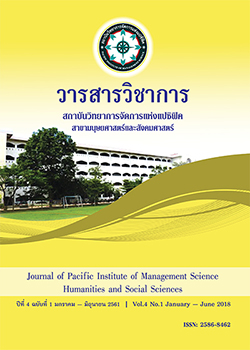Factors Affecting the Competitivenessof Small and Medium Muslim Entrepreneur in Three Southern Border Provinces
Keywords:
Islamic perspective, Marketing capability, Adaptability, Product Development, Competitive strategy, Competitive advantageAbstract
In this research, the researcher examines the causal influences of factors on the competitiveness of small and medium sized Muslim entrepreneurs in three provinces south border of Thailand.
In carrying out this investigation, the researcher collected data from 384 small and medium Muslim entrepreneurs in order to develop an appropriate structural equation model (SEM). Subsequently the data were analyzed by applications of the Statistical Product and Service Solutions for Personal Computers (SPSS/PC) software program and the linear structural relations (LISREL) software program.
In studying the factors influencing competitiveness, the researcher found that there were five major factors: Islamic perspective; marketing capability; adaptability; product development and competitive strategy. In determining the causal influences of these major factors, the researcher found the following: The adjusted model showed congruence with empirical data at a good level with Chi-square = 704.62, df = 283, (χ²/df) = 2.489 although it is over 2.00 but not more than 5. it is acceptable to statistically, P-value = 0.00, GFI = 0.92, AGFI = 0.91 and RMSEA = 0.062 even though it is above 0.05 but it is at a good level and acceptable in statistical terms. The results show that the modified equation model in the overall corresponds to the empirical data.
Findings are as follows: Islamic perspective exhibited positive direct influence on marketing capability at the statistically significant level of .01. Islamic perspective evinced positive direct influence on adaptability at the statistically significant level of .01. Islamic perspective exhibited positive direct influence on product development at the statistically significant level of .01. Islamic perspective evinced positive direct influence on competitive strategic at the statistically significant level of .01. Islamic perspective displayed positive direct influence on competitive advantage at the statistically significant level of .01. Marketing capability showed positive direct influence on competitive advantage at the statistically significant level of .05. Adaptability evinced positive direct influence on competitive strategic at the statistically significant level of .01. Product development displayed positive direct influence on competitive advantage at the statistically significant level of .01. Competitive strategy exhibited positive direct influence on competitive advantage at the statistically significant level of .01. Finally, Islamic perspective displayed positive indirect influence on competitive advantage through marketing capability, adaptability, product development and competitive strategy at the statistically significant level of .01.
References
สำนักงานส่งเสริมวิสาหกิจขนาดกลางและขนาดย่อม. (2559). จำนวนผู้ประกอบการ. ค้นเมื่อ 1 กุมภาพันธ์ 2559, จาก http://119.63.93.73/smephase3/
Abuznaid, S. (2012). Islamic Marketing: Addressing the Muslim Market, An - Najah Univ. J. Res. (Humanities). Vol. 26(6), pp. 1473-1503.
Ahmed, H. (2006). Islamic Law, Adaptability and Financial Development. Islamic Economic Studies, Vol. 13, No. 2
Al-Salem, F. H. (2009) Islamic financial product innovation, International Journal of Islamic and Middle Eastern Finance and Management Vol. 2 No. 3, pp. 187-200.
Baumol and William J. (1968). Entrepreneurship in Economic Theory. American Economic Review, 58 (2), pp. 64–71.
Garcia – Salmones, L. & Yin, J. Z. (2014). Developing Adaptability for New Competitive Advantage. ASEAN JOURNAL OF MANAGEMENT & INNOVATION, pp. 3-5.
Hoque, N., Mamun, A. and Ahshanul Mamun, A.M. (2013) Dynamics and traits of entrepreneurship: An Islamic approach, World Journal of Entrepreneurship, Management and Sustainable Development Vol. 10 No. 2, pp. 128-142.
Hu, L-T., & Bentler, P. M. (1999). Cutoff criteria for fit indexes in covariance structure analysis: Conventional criteria versus new alternatives. Structural Equation Modeling, 6(1), 1-55.
Keilbach, M. & Sanders, M. (2007). Exploration and Exploitation - The Role of Entrepreneurship and R+D in the Process of Innovation, Jena Economic Research Papers 2007-108,Friedrich-Schiller-University Jena.
Miller, D. (1987), The structural and environmental correlates of business strategy, Strategic Management Journal, 8(1), pp. 55-76.
Porter, M. E. The Competitive Advantage of Nations. New York: Free Press, 1990.
Vazirzanjani, H. R. & Hooshmand, A. (2016). Competitive Advantage Based on New Product Development. International Academic Journal of Business Management, Vol. 3, pp. 66-71.
Waxweiler, R.J., Roscoe, R.J., Archer, V.E., Thun, M.J., Wagoner, J.K. & Lundin,F.E. (1981) Mortality follow-up through 1977 of the white underground uranium mines cohort examined by the US Public Health Service. In: Gomez, M., ed., Radiation Hazards in Mining: Control, Measurement, and Medical Aspects, New York, New York Society of Mining Engineers of the American Institute of Mining, Metallurgical and Petroleum Engineers, Inc., pp.
Downloads
Published
Issue
Section
License
บทความที่ได้รับการตีพิมพ์เป็นลิขสิทธิ์ของ สถาบันวิทยาการจัดการแห่งแปซิฟิค
ข้อความที่ปรากฏในบทความแต่ละเรื่องในวารสารวิชาการเล่มนี้เป็นความคิดเห็นส่วนตัวของผู้เขียนแต่ละท่านไม่เกี่ยวข้องกับสถาบันวิทยาการจัดการแห่งแปซิฟิค และคณาจารย์ท่านอื่นๆในสถาบันฯ แต่อย่างใด ความรับผิดชอบองค์ประกอบทั้งหมดของบทความแต่ละเรื่องเป็นของผู้เขียนแต่ละท่าน หากมีความผิดพลาดใดๆ ผู้เขียนแต่ละท่านจะรับผิดชอบบทความของตนเองแต่ผู้เดียว







